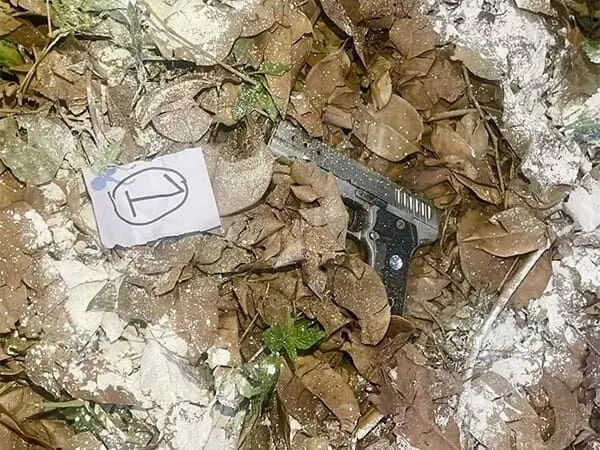SOURCE: IDRW.ORG


India’s ambitious push for self-reliance in unmanned aerial systems (UAS) is facing significant hurdles at the Aeronautical Test Range (ATR) near Chitradurga, Karnataka, as reported by aerospace journalist Anantha Krishnan M. Multiple UAV developers, both from government agencies and private industry, have voiced concerns over persistent delays caused by mandatory clearances from the Airports Authority of India (AAI).
These bureaucratic bottlenecks are disrupting critical testing schedules, even as the ATR emerges as a vital hub for India’s UAV ecosystem, particularly following the strategic lessons from Operation Sindoor earlier this month. The issue underscores the urgent need for regulatory reform to support India’s growing defense innovation, especially as platforms like CSIR-NAL’s High-Altitude Platform (HAP) UAV show promising advancements.
Continue readingSOURCE: IDRW.ORG


The rapid evolution of modern warfare has transformed the battlefield, shifting from prolonged mobilizations to agile, asymmetric conflicts where intelligent, battle-ready systems dictate strategic outcomes. Operation Sindoor, launched by India in response to a Pakistan-backed terror attack in April 2025, exemplified this new paradigm, showcasing the Indian Armed Forces’ ability to respond swiftly and decisively.
Amidst this high-stakes conflict, Big Bang Boom Solutions (BBBS), a Chennai-based defense startup, emerged as a key contributor with its Vajra Sentinel Anti-Drone Defence System. In a recently released statement, BBBS detailed the journey of the Vajra Sentinel—from a concept in a 500-square-foot boardroom to a battle-tested system protecting India’s borders—highlighting its role in countering drone threats during the operation and underscoring the importance of indigenous defense innovation.
Continue readingSOURCE: AFI


On May 20, 2025, a post by Tom Cooper on X highlighted a heated debate stemming from alleged claims by Pakistani academics regarding the Indian Air Force (IAF) Mirage 2000 aircraft. The claim suggested that a video showing a Pakistan Air Force JF-17C being shot down on May 7 couldn’t depict a JF-17 because its nose was black, implying the IAF Mirage 2000s have “black radomes.” Cooper’s detailed response dismantles this argument, exposing the misinformation and lack of research behind it. This article explores the controversy, the technical inaccuracies, and the broader implications of such claims.
The controversy originates from a supposed video of a Pakistan Air Force JF-17C being shot down, which some Pakistani academics challenged based on the aircraft’s nose color. They argued that the black nose in the video couldn’t belong to a JF-17C, as IAF Mirage 2000s are the ones with black radomes. This claim, as Cooper points out, reflects a misunderstanding of aircraft design, color profiles, and operational history.
Continue readingSOURCE: AFI


In a significant demonstration of India’s growing air defense capabilities, the indigenously developed Akash Short-Range Surface-to-Air Missile (SRSAM) system has successfully shot down a Fatah-1 missile, a short-range guided artillery rocket system produced by Pakistan. The Indian Air Force (IAF) recently showcased the debris of the intercepted Fatah-1 missile alongside the Akash Air Defense System (ADS), highlighting the system’s effectiveness against low-altitude, high-speed threats. This achievement underscores the Akash Mk1’s role as a cornerstone of India’s air defense network and its ability to counter evolving regional threats.
The Fatah-1, developed by Pakistan’s National Development Complex (NDC), is a short-range guided artillery rocket system with a reported range of 140 km. Launched from a multi-tube rocket system, the Fatah-1 is designed to deliver precision strikes against ground targets, equipped with a 150 kg high-explosive warhead. Its guided nature, likely using inertial navigation with GPS correction, allows for improved accuracy over unguided rockets, posing a challenge to air defense systems due to its high speed and low-altitude flight profile. The missile’s small radar cross-section (RCS) and potential for salvo launches make it a credible threat to forward-deployed military assets.
Continue readingSOURCE: AFI


In a striking demonstration of its air defense prowess, the Indian Army recently showcased fragments and debris of the Pakistani Hatf-I (also known as Hataf-1) battlefield missile, intercepted during a recent escalation along the border. This short-range, solid-fueled ballistic missile, developed by Pakistan, was neutralized by India’s advanced air defense systems, underscoring the nation’s ability to counter such threats effectively. The display of the Hatf-I debris, alongside other intercepted Pakistani and Chinese-origin munitions, highlights the Indian Armed Forces’ readiness to defend critical assets and civilian areas against a range of aerial threats.
The Hatf-I, designated as Target-1 (from the Urdu word “Hatf,” meaning “vengeance” or “deadly”), is a short-range ballistic missile (SRBM) developed by Pakistan’s Space and Upper Atmosphere Research Commission (SUPARCO) in collaboration with the Kahuta Research Laboratories (KRL). First revealed in 1989 and believed to have entered service with the Pakistan Army in 1992, the Hatf-I was designed as a battlefield weapon to counter India’s conventional military superiority, particularly in response to India’s Prithvi missile program.
Continue readingSOURCE: AFI


In a series of meticulously executed missile strikes during Operation Sindoor from May 7 to May 10, 2025, the Indian Air Force (IAF) demonstrated its capability to disable the Pakistan Air Force (PAF) on the ground, delivering a significant blow to Pakistan’s military ambitions. By targeting and damaging key airbase runways across Pakistan, including Nur Khan in Rawalpindi, Rahim Yar Khan in Punjab, and Mushaf in Sargodha, the IAF has effectively grounded a substantial portion of PAF’s operational capacity.
This operation not only highlights India’s growing precision-strike capabilities but also exposes the vulnerabilities of Pakistan’s heavily indebted military expansion, which has relied on massive loans to procure Chinese fighter jets and air defense systems.
Continue readingSOURCE: AFI


China’s military modernization has taken a significant leap with the development of the Shuiqiao-class amphibious platforms, aptly named “water bridges” (??), designed to bolster the People’s Liberation Army’s (PLA) capabilities for a potential invasion of Taiwan. These modular, self-propelled landing platform utility (LPU) barges, observed in exercises near Zhanjiang, Guangdong, in early 2025, are engineered to deploy heavy vehicles and troops across Taiwan’s challenging coastlines, bypassing traditional port dependencies.
As China accelerates its preparations for a possible cross-strait operation by 2027, in line with Xi Jinping’s centennial military goals, India faces a strategic dilemma: could this be an opportune moment to reclaim territories lost to China since 1947, such as Aksai Chin, thereby forcing the PLA into a two-front war? This article explores the Shuiqiao barges’ capabilities, their role in a Taiwan invasion scenario, and the feasibility and risks of India exploiting China’s preoccupation to pursue territorial objectives in the Himalayas.
Continue readingSOURCE: IANS


A delegation from India has met with the monitoring team of the United Nations (UN) Security Council’s panel that sanctions terrorists and provided it with evidence of The Resistance Front (TRF) carrying out the massacre in Pahalgam, according to sources.
Pressing India’s case for imposing sanctions on the front organisation of the Lashkar-e-Taiba (LeT), the delegation from India shared documentary evidence with the monitors, the sources said on Monday.
Continue readingSOURCE: IANS


India marked a prominent presence at the 17th edition of the Langkawi International Maritime and Aerospace Exhibition (LIMA 2025), with Minister of State for Defence Sanjay Seth meeting Malaysian Prime Minister YAB Dato’ Seri Anwar Bin Ibrahim during the event’s grand opening ceremony.
The event commenced on Tuesday with a grand opening ceremony attended by global defence and aerospace leaders.
Continue readingSOURCE: IANS


Intelligence Bureau (IB) chief Tapan Deka has been granted a one-year extension till June 2026, an official said on Tuesday. ‘Superspy’ Deka is known for expertise in handling Pakistan-sponsored terrorism and radicalisation-related cases and has a proven track record in handling matters related to Jammu and Kashmir as well as in the Northeast region.
He also has experience in leading operations against the terror group Indian Mujahideen, which was behind subversive activities across the country in the 2000s.
Continue readingSOURCE: ANI


Lt Gen Sumer Ivan D’Cunha, Director General of Army Air Defence, on Monday highlighted the country’s military capabilities and stated that India possesses the arsenal capability of striking targets across the full depth of Pakistan in the backdrop of Operation Sindoor.
In an interview with ANI, Lt Gen D’Cunha said, “The whole of Pakistan is within range.” He stated that even if they relocate the Pakistan Army’s General Headquarters (GHQ) from Rawalpindi to regions like Khyber Pakhtunkhwa (KPK), they will have to “find a deep hole.”
Continue readingSOURCE: PTI


A British Kashmiri Professor of Politics and International Relations at London’s University of Westminster has claimed her Overseas Citizenship of India (OCI) has been cancelled by the Indian authorities over alleged “anti-India activities”.
Nitasha Kaul took to social media on Sunday to post details of the communication received from the government of India, which accuses her of being motivated by “malice and complete disregard for facts or history”.
Continue readingSOURCE: IANS


After 10 days of ceasefire between India and Pakistan, the Beating Retreat ceremony by the Border Security Force (BSF) is set to resume on Tuesday evening in a scaled-down version at the Attari-Wagah, Hussainiwala, and Fazilka borders, all situated in Punjab.
This comes after a 12-day pause amid military conflict between the two countries. Officials informed IANS that there will be no handshake with armed personnel on the Pakistani side or the opening of border gates; however, audiences will still be permitted to witness the ceremony.
Continue readingSOURCE: IANS


In a series of joint operations, the Army, in coordination with other forces, including police, has arrested 29 militants of different proscribed outfits and recovered 28 weapons, huge quantities of ammunition and explosives from different districts of Manipur, officials said on Tuesday.
A Defence spokesman said the Army, Assam Rifles, Central Armed Police Force (CAPF) — CRPF, BSF, ITBP — and the Manipur Police in a series of joint operations during the past few days have recovered 28 weapons, including sophisticated arms, several improvised explosive devices (IEDs), some grenades, large cache of ammunition and war-like stores.
Continue readingSOURCE: ANI


In a significant crackdown, Punjab Police dismantled a terror module of the banned Babbar Khalsa International (BKI), backed by Pakistan’s ISI, and following an encounter arrested six operatives who were involved in a failed grenade attack on a liquor vend in Batala.
The terror operation was directed by foreign-based handlers Maninder Billa, based in Portugal, and Mannu Agwan, who recently took operational control of BKI following the arrest of Happy Passian in the United States. Punjab DGP Gaurav Yadav posted on X on Tuesday that the arrested individuals, identified as Jatin Kumar alias Rohan, Barinder Singh alias Sajan, Rahul Masih, Abraham alias Rohit, Sohit, and Sunil Kumar, were receiving direct instructions from Billa and Agwan, under the command of BKI mastermind Harwinder Singh Rinda.
Continue reading